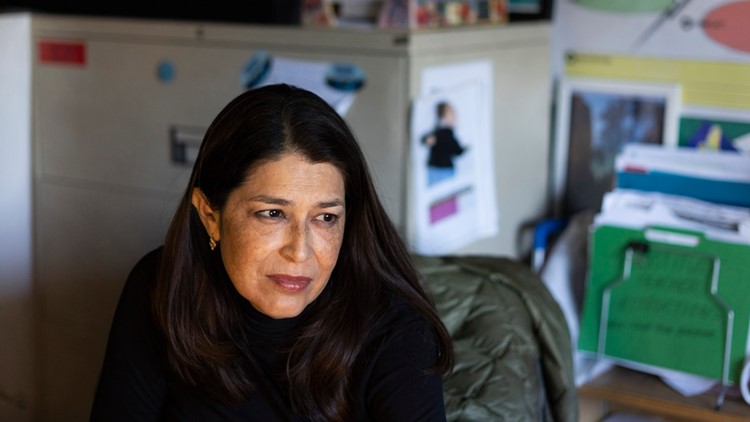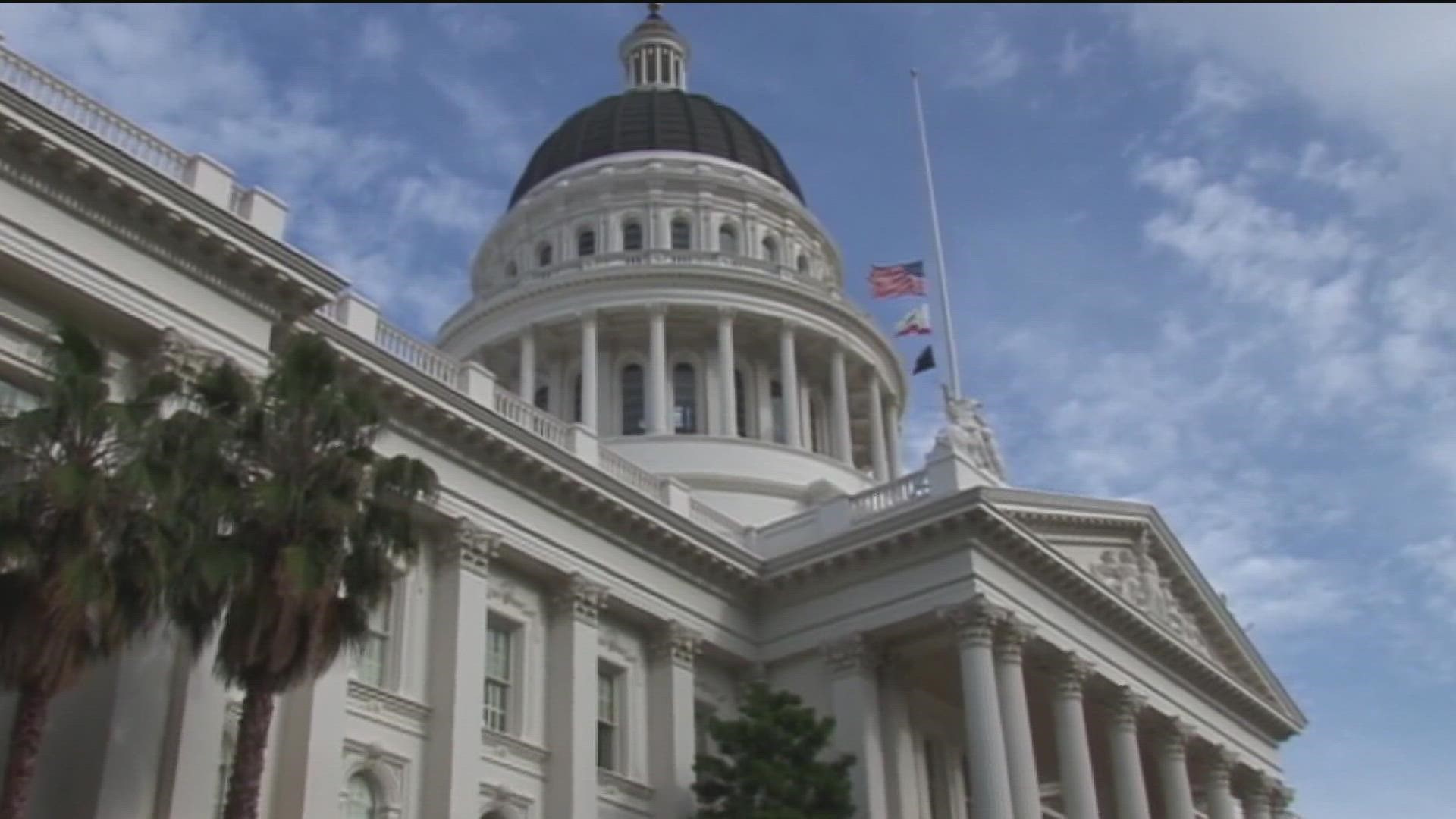CALIFORNIA, USA — Renata Garza-Silva loves movies — she longs to sit in a theater without having to worry about COVID-19 and whether others around her are masked.
Hillary Liber dreams about going back to the gym. She misses her in-person fitness classes, but for now a makeshift home workout space in the middle of her living room will have to do.
Garza-Silva, who is immunocompromised, and Liber, who is diabetic, are among the millions of Californians at greater risk of complications from a COVID-19 infection despite being fully vaccinated. Both women worry that the statewide protective measures that had given them some peace of mind during the pandemic are now lifting, increasing their susceptibility and limiting where they can go and what they can do.
Throughout California, people like Garza-Silva and Liber who have health conditions, such as heart disease, autoimmune disorders and diabetes, are forced to re-evaluate their risks. Every day, they ask themselves whether buying groceries, going to work, eating at a restaurant or visiting the post office is worth the risk of contracting a virus that could leave them hospitalized — or worse.
For people at higher risk, the pandemic has meant walking a fine line for two years. “I’m always balancing out the fear of missing out with the fear of going out,” Liber said.
Under state guidelines that were loosened last week, vaccinated people now can go maskless in indoor public spaces, except health care facilities, schools and prisons. Garza-Silva said this amplifies her worries, and she’s upset that state health officials have virtually ignored people like her when setting guidelines for returning life to “normal.”
“People in my position, young children and older people are just ignored. We don’t count whatsoever,” said Garza-Silva, 48, a middle school teacher and resident of La Crescenta whose immune system is weakened because of medication she takes after a kidney transplant. “I don’t know that people understand how many of us there are.”
About a third of adults in California — close to 10 million people — are at elevated risk of serious complications from COVID-19, according to a 2020 report from the Kaiser Family Foundation. This includes 6 million people who are 65 and older, but also millions of others with heart disease, diabetes, lung disorders, obesity and other conditions. (The data did not include seniors in nursing homes or children.)
Organ transplant patients and those undergoing cancer treatment or taking anti-inflammatory steroids — which are used to treat autoimmune diseases such rheumatoid arthritis and lupus — are among those considered “moderately or severely immunocompromised,” according to the US Centers for Disease Control and Prevention. Nationwide about 3% of adults are estimated to be on immunosuppressive medication.
Others with chronic illnesses should also continue to be more cautious, experts say. The CDC lists people with diabetes, chronic obstructive pulmonary disease, heart failure, coronary artery disease and kidney disease, among others, as likely to get very sick from COVID-19.
In California, 2.5 million people have been diagnosed with diabetes, but millions more are estimated to be undiagnosed or prediabetic. And 7% of adults in California — about 2.1 million people — have been diagnosed with heart disease.
Vaccines offer some protection
Many people with health conditions gain strong protection from vaccines, experts say, but others less so.
Transplant patients, like Garza-Silva, take immunosuppressive drugs so their immune system won’t attack their new organ, leaving them vulnerable to infections. For some, the first two doses of the vaccine do not provide adequate protection, and in some cases, even a third dose hasn’t been sufficient, prompting federal health officials to allow people with compromised immune systems to receive a fourth dose.
Garza-Silva has received three doses and is talking to her doctor about the fourth.
“Being fully vaccinated protects you dramatically, even if you have a chronic condition,” said Dr. Mark Henderson, an internal medicine physician at UC Davis Health.
Still, they face an elevated risk. At Henderson’s hospital, about 20% of people hospitalized for COVID-19 are vaccinated — most of them have a health condition that makes them susceptible.
Diabetes, for example, is known to affect immune function, Henderson explained. “White blood cells, which are the basis of fighting infections, don’t work the same way on diabetics.”
Diabetes was listed as an underlying condition in 15% of COVID-19 deaths nationwide.
As the state and nation look to turn the page on the pandemic, these patients, as well as older residents, have to be more vigilant in keeping up with boosters and wearing masks, Henderson said.
“The pandemic has always been about the vulnerable. In terms of the havoc that it’s wreaked, it has been about the elderly, the medically vulnerable and now those who are unvaccinated,” Henderson said.
Andy Imparato, director of Disability Rights California, said that unlike conversations around vaccine distribution in which advocates were able to provide input, they were not invited to discuss the state’s SMARTER plan, a blueprint released last week that will set the stage for the next phase of the pandemic.
The plan sets preparedness goals that state officials say will help them quickly respond and adapt to changing conditions, including new variants. But the 30-page document mentions people with underlying medical conditions only to emphasize that they use masks and stay up-to-date on their shots.
Under the state’s existing guidelines, vaccinated people can go maskless in most public places. People who are unvaccinated must still wear a mask in all public settings, although throughout the pandemic, the rules have rarely been enforced, mostly leaving it up to businesses to decide whether to check vaccination status. And even then, vaccinated people can still transmit the virus.
High-risk individuals can’t live in a bubble. People with health conditions or disabilities, for example, often depend on others for assistance. Many people with heart disease or diabetes have to venture out into the world to work.
“We want the state to recognize those who even after they have been vaccinated are at high risk,” Imparato said. “We recognize that the state is trying to balance competing demands, including keeping business afloat and helping people resume their lives, but we don’t want it to happen prematurely.”
The state is also expected to soon set a date for when masks will be able to come off inside schools.
The imminent end of indoor masking at schools concerns Garza-Silva, who teaches middle school film appreciation for the Los Angeles Unified School District. In a sign of loosening protections, the district announced Friday that it is lifting its outdoor mask mandate.
Her students, she said, are very understanding of her immunocompromised condition and are good about wearing masks in the classroom. She keeps windows and doors open for better airflow. She doesn’t know what will happen when masks are no longer required in schools.
“Our principal has been very supportive, and maybe it will be OK for students to wear masks at least for my class, I really don’t know,” she said.
Earlier this month, a Placer County high school teacher, who was fully vaccinated but had suppressed immunity from prescriptions treating his autoimmune order, died from COVID after returning to the classroom.
Looking to the future
One hopeful sign is that therapeutics, like Remdesivir, are now much more widely available than in the earlier days — although during the omicron surge supply still struggled to keep up with demand, said Dr. Shira Abeles, an infectious disease specialist at UC San Diego Health.
Also, another recently approved drug, known as Evusheld, can be used as a preventive measure, before infection, for those at highest risk, although that is still only available in more limited supplies.
Liber, who lives in San Diego, said one of her friend’s who also is high risk was treated with monoclonal antibodies when they caught COVID, “but there’s no guarantee it’ll be available if I need it.”
Her Type 1 diabetes is well-managed, but she knows that in combination with her age, 68, “back to normal” for her may still be a long way off. But “I’m not 15 anymore, I don’t have my whole life ahead of me,” she said.
People older than 65 account for 71% of COVID-19 deaths in California. About 84% of older Californians are vaccinated with two doses and 72% are boosted.
At the beginning of the pandemic, Liber and her husband were on total lockdown, rarely leaving their house. “We got really good at Amazon and Instacart,” she said.
Vaccines and stricter mask guidelines gave her some confidence to resume some of her favorite activities.
When cases came down and things started to look a little better, she journeyed to restaurants to eat outdoors on patios. It’s happened so infrequently in the last two years that she knows exactly how many times she’s dined out — five.
But every surge sends her back inside, and she fears pandemic-weary people will forget about people like her and stop taking precautions.
“I still want to do things,” she said, “I don’t want to give up on life.”
WATCH RELATED: California lifts indoor mask mandate for the fully vaccinated



